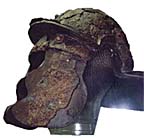 "Suetonius chose a position in a defile, with a wood behind him," explains military historian Martin Marix Evans. "There could be no enemy, he knew, except at his front, where there was open country without cover for ambushes."
"Suetonius chose a position in a defile, with a wood behind him," explains military historian Martin Marix Evans. "There could be no enemy, he knew, except at his front, where there was open country without cover for ambushes."
With archaeological estimates for a British population now at upwards of five million in Boudica's time - a figure not reached again until the 17th century - it is possible she had well over 100,000, not an army but a whole people bent on revenge.
"Grandparents, children, carts, cows," said Marix Evans. He estimates that Suetonius had something like 10,000, all regular soldiers.
"So, just as at Agincourt, he has to get the enormous enemy into a funnel. And here, beside this stream, under what would then have been a wooded hill, he has it, his army backed like a hermit crab in its shell. One and a half legions, men standing six feet apart to throw their javelins, a front of getting on for half a mile, auxiliary troops and cavalry on the slopes."
The two javelins thrown, which would have checked the British charge, the shields come down and the short swords begin stabbing.
No comments:
Post a Comment